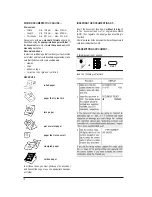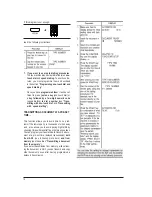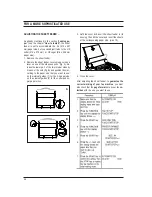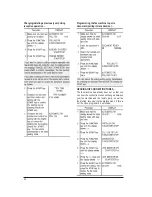
15
IF THE TRANSMISSION IS NOT
SUCCESSFUL ...
1 . Sometimes, because problems such as overloaded
telephone lines or other types of disturbance, the trans-
mitted document received by the remote party is gar-
bled retransmit it.
In this case, it is better to retransmit the docu-
ment at a lower speed. The fax normally trans-
mits at a speed of 9600 bps (bit per second), you
can this speed half (4800 bps), following the pro-
cedure described in the section “Reducing the
transmission speed”, chapter “For a more so-
phisticated use”.
2. If the transmission is not carried out because
of line or fax anomalies, the ERROR led lights
and the fax beeps; in this case, the fax machine
prints automatically the transmission report (see
the section “Printing reports and lists”), in which
the error code indicates the cause (you will find
a list of all the error codes in chapter “Keeping it
efficient”).
When the print-out of the transmission report is
completed, press the STOP key to eject the origi-
nal document from ADF. If the document to be
removed consists of more than one sheet, remove
manually all the sheets except the one that has
been already inserted in ADF, then press the
STOP key to eject the first one.
If you have set a transmission from memory, you
can try to re-send it (see the previous section).
3. If you attempt to transmit a document that is
too long (more than 600 mm) or if the docu-
ment jams during the transmission, the fax ma-
chine interrupts automatically the transmission
and beeps to warn you.
RECEIVING A DOCUMENT ...
You can set your fax machine to receive the docu-
ments sent by your remote party in four different
ways. You can access the mode required by press-
ing the RX MODE key.
•
Manual reception, for situations in which you are
present and you personally answer the incom-
ing calls. This reception models advisable when
the fax and the telephone are connected to a sin-
gle telephone line and the incoming document
flow is not very high so there is not much inter-
ference with telephone calls.
•
Automatic reception. This reception mode (the
standard setting for your fax machine) is more
indicated when you have two telephone con-
nection lines, one for the telephone and the oth-
er for the fax only. In this way there is no interfer-
ence between the two call flows (telephone and
fax calls).
•
Automatic reception with call type recogni-
tion. This reception mode, more practical then
the manual one, is ideal when you have only one
telephone line for the fax machine and the tele-
phone.
•
External telephone answering device recep-
tion. With this reception mode, the answering de-
vice receives the calls, records any messages
from your remote party and permits the fax to
receive any documents sent to you.
The fax machine, thanks to its memory, will be
able to receive even if:
• the paper, the ink or the print head run out
• the print head compartment cover is open.
If when receiving a document, you run out of
paper, the paper jams, you run out of ink or
you open the print head compartment cover,
the printing is interrupted. The display shows the
appropriate message and the document that you
are receiving is temporarily recorded in the
memory. Once the error is corrected, the fax ma-
chine resumes printing.
If you want to interrupt the reception in progress,
press the STOP key twice; the first time to inter-
rupt reception; the second time to restore the fax
to the initial waiting mode.
If you receive a document which is too long
(longer than the paper size used for reception),
you can programme your fax to print on another
sheet the excess text (see "Receiving a docu-
ment longer than the paper size", chapter "For
a more sophisticated use").
You can also reduce the print area of a received
document (see "Reducing the print area of a
received document", chapter "For a more so-
phisticated use").
For further information regarding the reception
mode, refer to the specific section.
















































